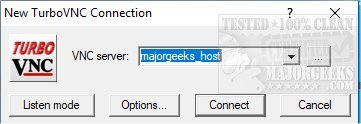TurboVNC 3.2.1 has been released, offering a high-performance, enterprise-quality version of the Virtual Network Computing (VNC) protocol for both Windows and Linux systems. This software is built on the foundations of TightVNC, TigerVNC, and X.org, making it a robust solution for efficient VNC server connections.
One of the standout features of TurboVNC is its implementation of a Tight encoding variant that optimizes performance and compression, particularly for 3D applications, videos, and other image-heavy workloads. When used alongside VirtualGL, TurboVNC enables the remote display of 3D applications with interactive performance that is comparable to local execution. Additionally, TurboVNC's high-speed encoding techniques have been adopted by TigerVNC and libvncserver, ensuring compatibility with other TightVNC derivatives.
Originally forked from TightVNC in 2004, TurboVNC retains all of TightVNC 1.3.x features while introducing significant enhancements and bug fixes. It outperforms TightVNC in compressing 3D and video workloads, achieving this with only 5-20% of the CPU usage required by TightVNC. On modern hardware, TurboVNC can stream over 50 Megapixels per second on a 100 Megabit local area network with perceptually lossless image quality, while still managing to stream 10-12 Megapixels per second over a 5 Megabit broadband connection at reduced image quality.
Key features of TurboVNC include:
- Fine control over JPEG image quality and chrominance subsampling
- Client-side double buffering to minimize tearing artifacts during 3D and video playback
- Flexible full-screen and multi-screen support
- Comprehensive IPv6 support
- Advanced flow control for improved performance on high-latency connections
- Authentication options including one-time passwords and Unix login credentials, alongside standard VNC passwords
- Access control lists to share sessions with specific users
- Global security/authentication policy settings for server machines
- Multithreaded encoding capabilities
- A “lossless refresh” feature for requesting a lossless copy of the screen image
- A high-performance Java viewer that utilizes Java Web Start for easy deployment and native performance through JNI.
This release marks a significant step in enhancing remote desktop capabilities, especially for users needing to work with graphics-intensive applications. As TurboVNC continues to evolve, its combination of speed, efficiency, and robust features makes it a valuable tool for enterprises and individual users alike. Future updates may further refine its capabilities, improve user experience, and expand compatibility with emerging technologies
One of the standout features of TurboVNC is its implementation of a Tight encoding variant that optimizes performance and compression, particularly for 3D applications, videos, and other image-heavy workloads. When used alongside VirtualGL, TurboVNC enables the remote display of 3D applications with interactive performance that is comparable to local execution. Additionally, TurboVNC's high-speed encoding techniques have been adopted by TigerVNC and libvncserver, ensuring compatibility with other TightVNC derivatives.
Originally forked from TightVNC in 2004, TurboVNC retains all of TightVNC 1.3.x features while introducing significant enhancements and bug fixes. It outperforms TightVNC in compressing 3D and video workloads, achieving this with only 5-20% of the CPU usage required by TightVNC. On modern hardware, TurboVNC can stream over 50 Megapixels per second on a 100 Megabit local area network with perceptually lossless image quality, while still managing to stream 10-12 Megapixels per second over a 5 Megabit broadband connection at reduced image quality.
Key features of TurboVNC include:
- Fine control over JPEG image quality and chrominance subsampling
- Client-side double buffering to minimize tearing artifacts during 3D and video playback
- Flexible full-screen and multi-screen support
- Comprehensive IPv6 support
- Advanced flow control for improved performance on high-latency connections
- Authentication options including one-time passwords and Unix login credentials, alongside standard VNC passwords
- Access control lists to share sessions with specific users
- Global security/authentication policy settings for server machines
- Multithreaded encoding capabilities
- A “lossless refresh” feature for requesting a lossless copy of the screen image
- A high-performance Java viewer that utilizes Java Web Start for easy deployment and native performance through JNI.
This release marks a significant step in enhancing remote desktop capabilities, especially for users needing to work with graphics-intensive applications. As TurboVNC continues to evolve, its combination of speed, efficiency, and robust features makes it a valuable tool for enterprises and individual users alike. Future updates may further refine its capabilities, improve user experience, and expand compatibility with emerging technologies
TurboVNC 3.2.1 released
TurboVNC is a high-performance, enterprise-quality version of VNC for Windows and Linux based on TightVNC, TigerVNC, and X.org that allows efficient VNC server connections.


